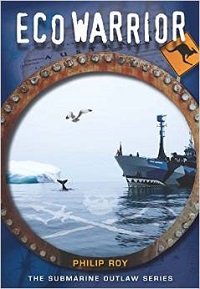| ________________
CM . . .
. Volume XXI Number . . . .June 19, 2015
excerpt:
Eco Warrior is the seventh book in “The Submarine Outlaw” series about Alfred, a young man sailing around the world in a submarine he built himself. Each book is a complete story unto itself; the series as a whole traces Alfred's growth as a character. Eco Warrior opens with Al in the middle of the Indian Ocean on his way from South Africa to Australia. He falls off the submarine and is only saved because the rope stuck in the propeller makes the submarine sail in a big circle. After that dramatic opening, Alfred finds an old woman becalmed on a small sailboat; he fixes her engine and gives her more fuel. When he shares his intention to become an environmentalist, she tells him it's much too late to save the oceans because the damage already done is too severe. Despite her pessimistic opinion, Alfred continues to Perth and encounters people working with Paul Watson and the Sea Shepherd Society. When someone sabotages a tanker ship, Al is certain he will be blamed, and so he runs away inland and tries to hide. A sympathetic local picks him up and helps him sneak back to his submarine and out of the harbour. Although he had finally gotten himself official papers in South Africa, Alfred is an outlaw again. Alfred heads to Tasmania where he looks up a friend of the environmentalists. Merwin is an artist and an inventor, and he is trying to build his own submarine although his lacks a number of practical elements, including watertightness. Merwin convinces Alfred against his better judgment to let Merwin sail with him for a while. When they see an oil tanker heading south illegally to refuel whaling ships in the Antarctic, Merwin insists that they follow it though they can't think of anything they could do to stop it. Thus, they are present when two Sea Shepherd ships intercept the tanker and force it to turn around. Thrilled at this victory for the environmentalists, Al and Merwin follow the tanker to make sure it keeps going north. A mother whale and her baby follow the submarine, and Merwin fulfills a lifelong dream of swimming with whales. The tanker veers off course and meets up with the whaling ships. Merwin tries to be heroic and is injured by a water cannon. The mother whale is killed by a whaler before Alfred can do anything to prevent it. Then the Sea Shepherd ships arrive and drive the tanker and the whaler north and out of protected waters. The characters Alfred meets are all distinct, interesting people with their own perspectives on how to save the ocean. Alfred learns from each of them while reserving his own judgment as each character has certain quirks that don't quite fit with Alfred's way of thinking. He shows immaturity in letting himself be used by people with their own agendas, but he also learns to assert himself. At the end of the novel, he realizes that he doesn't know enough yet to know how to best fight for the environment, and he chooses to go to Japan to learn more about the whaling industry. The plot of Eco Warrior is thinner than the previous two books in the series, Outlaw in India and Seas of South Africa, but it still has exciting incident and suspense. Because the ecological theme occasionally sounds preachy and is not wrapped up with other social/political themes as it was in Seas of South Africa, teens may be put off by the one-note message, but Alfred is still a convincing character, and his passion for saving the ocean feels genuine. Young readers may find the ending anti-climactic as Alfred fails to do anything useful and could be seen as responsible for the whale getting killed; older readers will appreciate the realism of this ambiguous conclusion. Younger readers will be upset by the death of the whale, but there is much less violence in this book than in the previous one. Highly Recommended.
Kim Aippersbach is a writer, editor and mother of three in Vancouver, BC.
To comment on this title or this review, send mail to cm@umanitoba.ca.
Copyright © the Manitoba Library Association. Reproduction for personal use is permitted only if this copyright notice is maintained. Any
other reproduction is prohibited without permission.
CM Home |
Next Review |
(Table of Contents for This Issue - June 19, 2015.)
| Back Issues | Search | CM Archive
| Profiles Archive |
